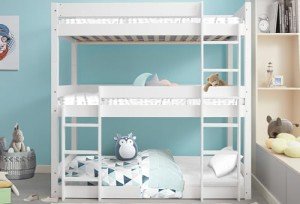Bunk Beds Sale: A Comprehensive Guide to Choosing the Right Bunk Bed for Your Home
Bunk beds have long been a staple in kids's bed rooms, using a combination of space-saving effectiveness and enjoyable. Whether accommodating siblings, friends on slumber parties, or simply making the most of a playroom, bunk beds have ended up being an essential element in contemporary household homes. As sales on bunk beds increase, it ends up being significantly important for customers to make educated decisions when buying one. This post will cover the fundamentals of purchasing a bunk bed, from types to security functions, as well as tips for preserving the integrity of your investment.
Types of Bunk Beds
When considering a bunk bed sale, it's essential to comprehend the various styles readily available on the market. Below are the most common types:
- Traditional Bunk Beds: These consist of two beds stacked one above the other, sharing a single frame. They are frequently the most cost-effective option.
- L-Shaped Bunk Beds: This style includes one bed placed vertically and another horizontally. This arrangement creates additional space below the upper bed, which can be utilized for storage or a play area.
- Lofted Beds: Similar to standard bunk beds but with no lower bed. Rather, the space underneath can be made use of for a desk, play location, or extra storage.
- Triple Bunk Beds: For households with a larger variety of children or regular slumber parties, triple bunk beds offer three sleeping locations in a space-efficient design.
- Futon Bunk Beds: These styles combine bunk beds and futon sofas. The bottom section converts into a different seating location, enhancing performance.
- Convertible Bunk Beds: These beds can be separated into 2 specific beds, making them versatile as kids's needs change in time.
Table 1: Comparison of Bunk Bed Types
| Type | Description | Space Efficiency | Additional Features |
|---|---|---|---|
| Conventional Bunk Bed | Two beds stacked vertically | High | Simplest style |
| L-Shaped Bunk Bed | One vertical and one horizontal bed | Moderate | Play or storage space |
| Lofted Bed | Elevated bed with open space listed below | High | Work/play area |
| Triple Bunk Bed | Three stacked beds | Really High | Accommodates more users |
| Futon Bunk Bed | Bunk bed with a convertible futon | High | Multi-functional |
| Convertible Bunk Bed | Can be divided into two different beds | Moderate | Versatility & & longevity |
Safety Features to Consider
Safety is vital when investing in a bunk bed. Below are key security features to try to find:
- Guardrails: Adequate guardrails ought to be present on both sides of the upper bunk to prevent falls. They must be at least 5 inches greater than the bed mattress.
- Ladder Design: Look for strong, broad ladders with slip-resistant rungs. Ensure that the angle is not too steep for easy access.
- Stability: Ensure the bed is built with strong materials, such as solid wood or durable metal. image source should not wobble when in use.
- Weight Limit: Check the weight capability of the bunk bed to ensure it can accommodate the designated users safely.
- Material Safety: If possible, select beds made from non-toxic products or those fulfilling safety standards for kids's furniture.
Table 2: Essential Safety Features
| Feature | Description | Significance |
|---|---|---|
| Guardrails | Sides of upper bed to prevent falls | Necessary for kid security |
| Ladder Design | Strong, slip-resistant rungs | Aids safe and simple access |
| Stability | Build quality to avoid wobbling | Guarantees security and durability |
| Weight Limit | Optimum weight capacity | Avoids mishaps |
| Product Safety | Non-toxic, safe products | Protects children's health |
Maintenance Tips for Bunk Beds
To extend the life of your bunk bed and make sure continuous safety, think about the following upkeep pointers:
- Regular Inspections: Periodically examine the structure for loose screws, bolts, or any signs of wear. Tighten up fasteners as needed.
- Clean Periodically: Dust and clean the surface areas routinely. Use appropriate cleaners that will not harm the surface.
- Inspect Weight Limits: Be conscious of weight limitations, especially with older children or adults who may wish to use the upper bunk.
- Prevent Climbing on Guardrails: Educate kids not to utilize guardrails for climbing up or playing to reduce the risk of accidents.
Frequently Asked Questions (FAQs)
Q1: What is the age limit for kids to securely use bunk beds?A: While it differs by the maker, many suggest that children under six should not sleep in the upper bunk due to security concerns.
Q2: How can moms and dads dissuade unsafe climbing?A: Setting clear rules about bunk bed usage and monitoring children can help. Furthermore, using a bed camping tent can discourage climbing while developing a fun sleep environment.
Q3: What should I think about when embellishing a space with bunk beds?A: Ensure there is sufficient space around the bunk bed for safe movement, and make use of the decoration to produce personalized areas for each kid.
Q4: Is a lofted bed ideal for older children?A: Yes, lofted beds can be appropriate for older children as long as they fulfill security requirements and the kid is responsible enough to utilize them safely.
Bunk beds serve a functional function while including an element of fun to a kid's bedroom. As sales of bunk beds continue to rise, cautious consideration of types, security features, and maintenance practices is necessary for parents and caregivers. By understanding these crucial factors, households can find the best bunk bed for their home, making sure both functionality and security for several years to come. Whether it's for brother or sisters sharing a room or producing a relaxing sleepover space, a well-chosen bunk bed can supply delight and practicality, making it a worthy investment.

